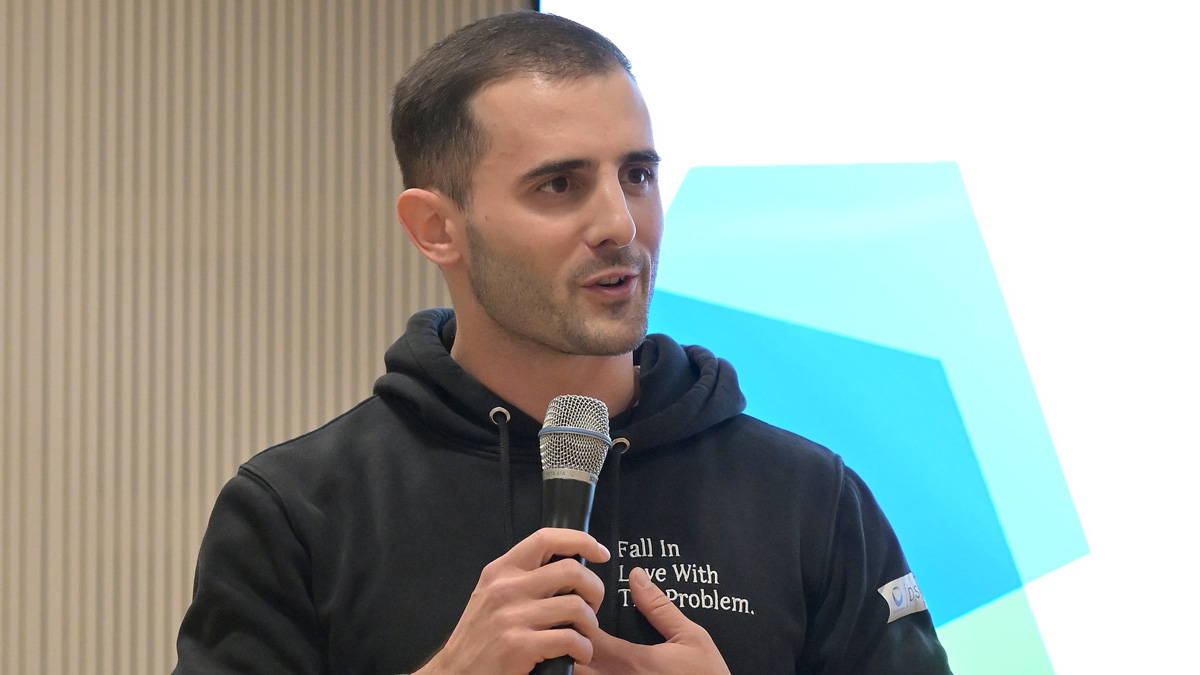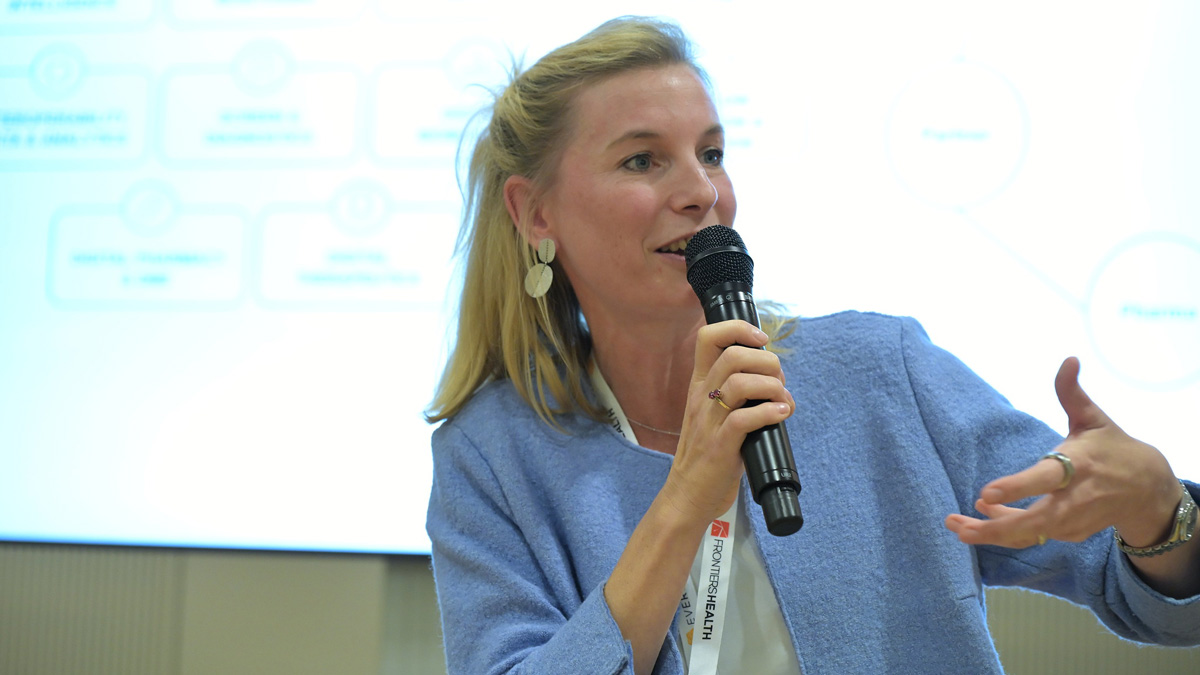Reimagining digital health partnerships: A practical guide from industry leaders

With billions invested and digital health initiatives on the rise, why do so few pharma-tech partnerships achieve lasting success? This pressing question brought together industry leaders, entrepreneurs, and investors at this year’s Frontiers Health conference in Berlin, where Daiichi Sankyo’s DSPACE team challenged attendees to explore new ideas in an open and interactive workshop session.
Led by DSPACE’s head, Anna-Maria Heidinger, senior digital innovation manager, Eduard Kirchner Sala, and Prof Florian Koerber, head of start-ups and M&A at Flying Health, the session opened with a refreshingly candid tone. “We’ve seen a lot of pilots that have sadly led to nowhere,” Kirchner Sala admitted, echoing a frustration common among digital health innovators.
Echoing the workshop’s topic of reimagining collaboration, the trio opted to inject some of the same excitement and idea sharing found in innovation, into the challenge of improving innovation systems. Rather than sit and listen, audience members were invited to occupy an extra empty seat alongside the core panellists and share their experiences, insights, and ideas to build a collaborative playbook for partnerships that deliver real value to patients and healthcare providers.
Falling in love with the problem
A central theme of the workshop was the importance of focusing on the underlying problems that these partnerships aim to solve. Kirchner Sala emphasised that successful digital health projects are often those driven by a deep understanding of patient needs, rather than by excitement over emerging technologies. Adopting this “falling in love with the problem” philosophy appeared to resonate with attendees, many of whom shared examples of projects that floundered due to a misplaced focus on the tools, as opposed to the issues they were meant to address.
This problem-first approach encourages us to move away from the transactional mindset that can often characterise traditional pharma partnerships. By prioritising the identification and understanding of core issues – such as patient monitoring and access, treatment adherence, and healthcare data integration –partnerships are more likely to generate lasting impact. Heidinger and Kirchner Sala both spoke to DSPACE’s focus on improving patient outcomes by exploring innovative, yet practical, solutions that serve unmet needs within healthcare. This mentality, they explained, allows the team to view digital health as an ecosystem that supports patients holistically, rather than just another product add-on.
While this approach sounds ideal, there are challenges. One audience member pointed out that the digital health landscape itself is going through a hype cycle, with some technologies like fitness trackers now well-established, while others, such as chatbots and digital therapeutics, are still finding their place in the market. This shifting landscape makes it crucial for digital health companies and their pharma partners to ground their collaborations in shared values and a clear understanding of the specific problem they aim to solve.

Aligning cultures and structures for success
As participants continued to pass the mic, one theme that quickly emerged was the importance of addressing the cultural and structural differences between pharma companies and tech start-ups –differences that, if unaddressed, can derail even the most promising projects.
Pharmaceutical companies bring extensive resources, regulatory expertise, and established networks to the table, making them powerful allies for smaller, more agile tech companies. However, their decision-making processes are often slower, and their structures can be cumbersome, hindering the kind of rapid innovation that digital health start-ups are built to deliver.
Start-ups, on the other hand, excel at agility and quick decision-making, yet often lack the resources and networks necessary to navigate regulatory and market access challenges. Successful partnerships hinge on both parties understanding these dynamics and working to bridge them. Participants highlighted that transparency, realistic timelines, and clear expectations are essential to aligning these divergent cultures. For instance, high turnover rates in start-ups can create project discontinuity, while pharma’s long development timelines can dampen momentum. Addressing these operational realities from the outset – such as clarifying team roles, setting short- and mid-term milestones, and ensuring mutual support – can create a more harmonious collaboration.
Koerber suggested that partnerships between pharma and digital health companies should be approached with the same care as personal relationships: “Do we share the same values and goals?” he asked, highlighting that trust and shared purpose are more valuable than transactional exchanges.
Workshop participants underscored this idea, agreeing that investing time in defining these shared values early on can prevent misunderstandings later in the partnership. Additionally, both parties should be upfront about what success looks like for them, making sure that these definitions are mutually understood. This approach creates a more resilient collaboration that can weather inevitable challenges.

Funding, data, and the challenge of execution
Securing sustained funding and demonstrating clinical value are among the biggest obstacles facing digital health partnerships, according to attendees. Even when pharma companies are open to supporting digital tools, audience members noted that securing reimbursement remains challenging and, without clear paths to funding, digital health solutions struggle to gain traction with healthcare providers. Similarly, data integration with hospital systems is often a significant hurdle, as healthcare providers demand evidence of a solution’s clinical benefit before integrating it into their workflows.
Audience members voiced concerns over another common challenge: personnel turnover within both pharma and start-up teams. When a project or problem is championed by one individual, if they move teams or leave a company entirely, their absence often disrupts project continuity and slows progress. In response, many agreed that partnerships benefit from having a stable management structure and a project manager who understands both the operational and strategic aspects of digital health. By maintaining consistent oversight, pharma companies can help ensure that projects remain aligned with their goals, even if team members change.
Another interesting point raised was the importance of setting realistic objectives and managing expectations. While long-term ambitions are essential, many partnerships falter because they aim too high too soon, without establishing achievable short-term wins. A phased approach – launching minimal viable products or simpler versions to side-step some regulatory complexities – can allow partnerships to achieve early milestones and build momentum for more complex iterations. This incremental approach aligns well with the start-up model, which values rapid iteration and learning, and can ease some of the regulatory and financial pressures that larger projects encounter.
Having dedicated much of the discussion to creative problem solving, one audience member paused to share a success story – ViiV Healthcare’s collaboration with Chelsea Westminster Hospital, where the pharma company funded a digital solution for managing HIV patients – noting that, while we often share examples of failure and challenges, it is just as important to reflect on moments of triumph.
After an initial phase supported by ViiV, he explained, the NHS took over funding for the programme, which has now expanded to other hospitals. This example highlighted how pharma can play a catalytic role, enabling digital health solutions to scale without being locked into long-term commitments. As Kirchner Sala noted, transparency and expectation management are crucial here, as pharma companies need to be clear about what they can realistically contribute in terms of time, funding, and expertise.
The session closed with a call to action from the DSPACE team, who urged participants – no matter their position within a company – to reconsider their approach to digital health collaborations. By creating an environment of mutual trust, clear communication, and shared goals, pharma and digital health start-ups can build partnerships that are not only innovative, but also sustainable.
Watch pharmaphroum’s editor Eloise McLennan’s interview with Anna-Maria Heidinger, Head of DSPACE at Daiichi Sankyo Europe at Frontiers Health 2024 here.
About DSPACE

For those interested in building such partnerships, DSPACE remains open to engaging with new ideas, unmet healthcare needs, and collaborative ventures. Reach out at ds-pace.com to explore the possibilities.











